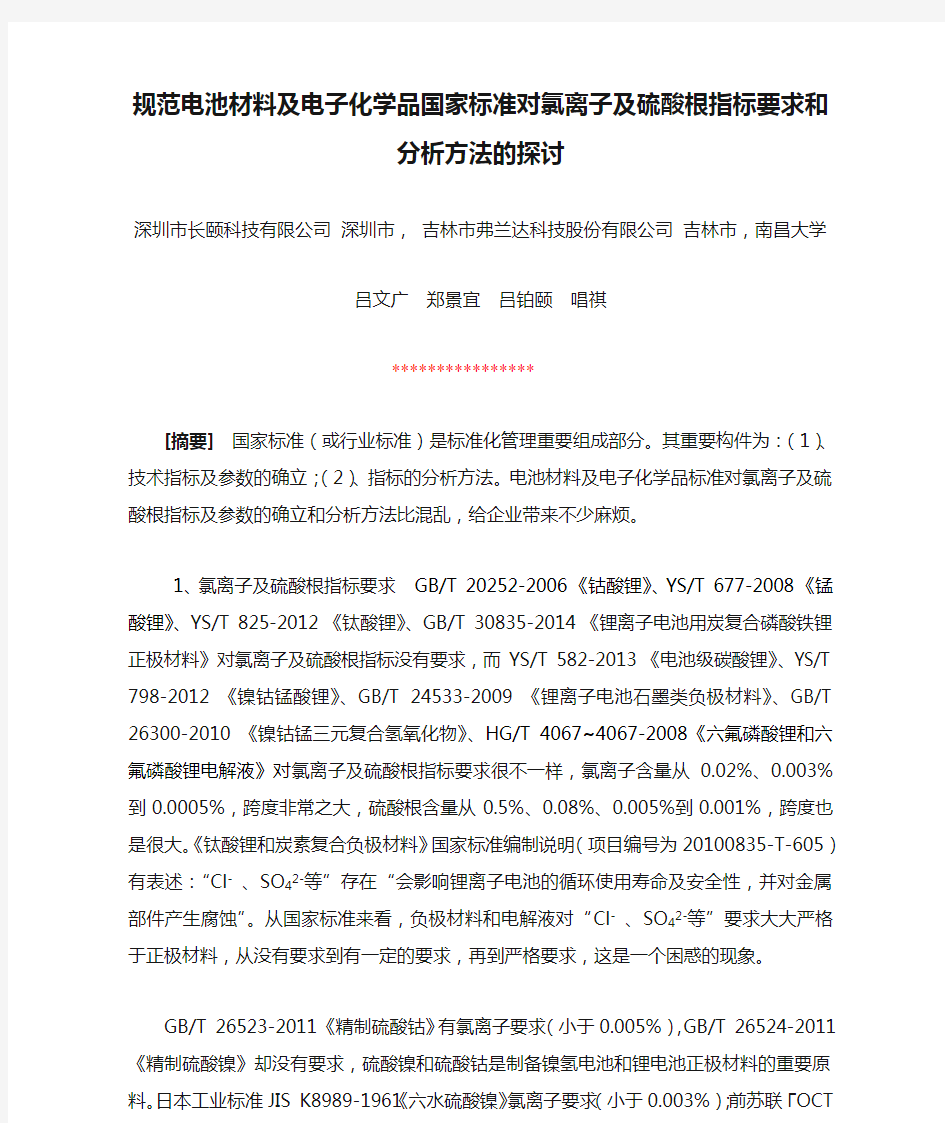

规范电池材料及电子化学品国家标准对氯离子及硫酸根指
标要求和分析方法的探讨
深圳市长颐科技有限公司深圳市,吉林市弗兰达科技股份有限公司吉林市,南昌大学
吕文广郑景宜吕铂颐唱祺
529635747@https://www.doczj.com/doc/f26119558.html,
[摘要]国家标准(或行业标准)是标准化管理重要组成部分。其重要构件为:(1)、技术指标及参数的确立;(2)、指标的分析方法。电池材料及电子化学品标准对氯离子及硫酸根指标及参数的确立和分析方法比混乱,给企业带来不少麻烦。
1、氯离子及硫酸根指标要求GB/T 20252-2006 《钴酸锂》、YS/T 677-2008 《锰酸锂》、YS/T 825-2012 《钛酸锂》、GB/T 30835-2014 《锂离子电池用炭复合磷酸铁锂正极材料》对氯离子及硫酸根指标没有要求,而YS/T 582-2013 《电池级碳酸锂》、YS/T 798-2012 《镍钴锰酸锂》、GB/T 24533-2009 《锂离子电池石墨类负极材料》、GB/T 26300-2010 《镍钴锰三元复合氢氧化物》、HG/T 4067~4067-2008《六氟磷酸锂和六氟磷酸锂电解液》对氯离子及硫酸根指标要求很不一样,氯离子含量从0.02%、0.003%到0.0005%,跨度非常之大,硫酸根含量从0.5%、0.08%、0.005%到0.001%,跨度也是很大。《钛酸锂和炭素复合负极材料》国家标准编制说明(项目编号为20100835-T-605)有表述:“Cl-、SO42-等”存在“会影响锂离子电池的循环使用寿命及安全性,并对金属部件产生腐蚀”。从国家标准来看,负极材料和电解液对“Cl-、SO42-等”要求大大严格于正极材料,从没有要求到有一定的要求,再到严格要求,这是一个困惑的现象。
GB/T 26523-2011 《精制硫酸钴》有氯离子要求(小于0.005%),GB/T 26524-2011《精制硫酸镍》却没有要求,硫酸镍和硫酸钴是制备镍氢电池和锂电池正极材料的重要原料。日本工业标准JIS K8989-1961《六水硫酸镍》氯离子要求(小于0.003%);前苏联ГОСТ2665-1986《工业硫酸镍技术条件》氯离子要求(小于0.1%),我国HG/T 2824- 1997《工业硫酸镍》采用前苏联的标准,后来修订标准把氯离子要求却删除了。现在应用的HG/T 2824-2009《工业硫酸镍》、GB/T 26524-2011《精制硫酸镍》都没有氯离子要求,然而,日本进口中国硫酸镍常有要求氯离子小于0.02%。
企业热衷参加标准起草是一个进步,然而,不真正研究技术指标与电池性能的关系,正确建立技术指标和参数,起不到应该有的效果。
2、氯离子及硫酸根检测方法目视比浊法是最经典的分析方法,最早在前苏联标准ГОСТ 4465-48《硫酸镍(试剂)》有描述。国内通用方法为GB/T 23945-2009 《无机化工产品中氯化物含量测定的通用方法目视比浊法》、GB/T23844-2009 《无机化工产品中硫酸盐测定通用方法目视比浊法》。目视比浊法测定氯离子及硫酸根由于具有灵敏度低,重现性差,操作复杂、如果溶液产生颜色,就无法正确判断,而且准确定量非常困难、人为因素等缺点,无法反映产品的真实质量,所以不能满足部分用户的需求。某公司硫酸镍出口日本,要求产品氯离子小于0.02%,氯化银比浊法只能测定含氯离子为0.02-0.10%,达不到硫酸镍的精度要求。
诸多分析科技人员研究成果:添加稳定剂(如丙三醇)联合分光光度测定,能大幅度提高分析结果准确度、精确度以及分析范围(氯离子0.001 0%~0.10%;硫酸根0.005 %-0.8%)。近年修订国家标准中得到应用。作者具有专利(《无机盐中硫酸根测定仪》专利号:ZL201020150286.9)。更优异的检测方法为离子色谱法。
3、结论产品标准化管理是一个系统工程,标准起草、修订工作须扎实搞清技术指标及参数与电池性能关联性,防止顾此失彼。目前国家标准氯离子及硫酸根技术指标、参数、检测方法比较混乱。改进的添加稳定剂(如丙三醇)联合分光光度测定法和离子色谱法是优选。
本文为多个项目之子课题之一。获“科技型中小企业技术创新基金立项(立项代码:11C26212200608);吉林省科技发展计划项目-工业高新技术(项目编号:20120376);吉林省科技发展计划项目-重点新产品补助项目(项目编号:20140415036JH);吉林市科技计划项目-战略性新兴产业科技创新专项(项目编号:201351026);2013年国家中小企业发展专项资金吉林省支持项目”支持。
A discussion on chloride ions and sulfate index requirements and analytical methods of Specification battery materials and electronic chemicals National Standard.
[Summary] National standards (or industry standard) is an important part of standardized management. Important components:(1)、Establishment of technical specifications and parameters;(2)、Indicators analysis. Chloride ions and sulfate index requirements and analytical methods of Specification battery materials and electronic chemicals standard is very confusing, to bring a lot of trouble.
1、The chloride ion and sulfate index requirements: GB/T 20252-2006 《Lithium cobalt oxide》、YS/T 677-2008 《Lithium manganese oxide》、YS/T 825-2012 《Lithium titanate》、GB/T 30835-2014 《Lithium-ion batteries with a carbon composite lithium iron phosphate cathode material》. These are not required to chloride ions and sulfate indicators. But YS/T 582-2013 《Battery grade lithium carbonate》、YS/T 798-2012 《Nickel, cobalt and manganese lithium》、GB/T 24533-2009 《Lithium-ion battery anode material graphite》、GB/T 26300-2010 《Nickel-cobalt-manganese ternary complex hydroxide》、HG/T 4067~4067-2008《Lithium hexafluorophosphate and lithium hexafluorophosphate electrolyte》, these chloride ions and sulfate index requirements are very different. Chloride ion contents are from 0.02% to 0.003% and 0.0005%, the span is very large. Sulfate contents from 0.5%, 0.08%, 0.005% to 0.001%, the span is great too. 《Lithium titanate and carbon composite anode material》Preparation of national standards (Item number 20100835-T-605) have expressed:“Cl-, SO42-, etc.”’s presence "will affect the lithium-ion battery cycle life and safety, and corrode metal parts." From the point of the national standard, anode materials and electrolyte on "Cl -, SO42 -, etc." is much strict on the anode material,from no requirement to have certain requirements, and strict requirements, this is a confusing phenomenon.
GB/T 26523-2011 《The refined cobalt sulfate》have the chloride ionrequirements(less than 0.005%),but GB/T 26524-2011《The refined nickel sulfate》is not. Nickel sulfate and cobalt sulfate are important raw materials for preparing nickel-metal hydride batteries and lithium battery cathode material. Japanese Industrial Standards JIS K8989-1961《Nickel sulfate hexahydrate》Chloride required(less than 0.003%);The former Soviet Union ГОСТ 2665-1986 "Industrial nickel sulfate technical conditions" Chloride required(less than 0.1%),Our HG / T 2824- 1997 "Industrial nickel sulfate" With the former Soviet Union standards, and later revised standard requires the chloride ion was removed. Now, HG/T 2824-2009《Industrial nickel sulfate》、GB/T 26524-2011《The refined nickel sulfate》have no requirement. However, from Chinese imports of nickel sulfate often requires chloride ions is less than 0.02% in Japan. Companies interested to participate in the drafting of standards is a step forward. However, do not really study the relationship between technical indicators and battery performance, technical indicators and parameters set up correctly, it should not achieve some effects.
2、Chloride and sulfate detection method
Visible turbidimetric method is the most classic analysis method, the first former Soviet Union standard ГОСТ 4465-48 "nickel sulfate (reagent)" is described. Domestic general methods are GB / T 23945-2009 "General method of inorganic chemical products determination of chloride content Visible turbidimetric method" and GB / T23844-2009 "Determination of Inorganic chemical products sulphate General Method Visible turbidimetric method." Due to low sensitivity, poor reproducibility, complex operation, if have any color solution, visual turbidity determination of chloride ions and sulfate can not judge properly. And because difficult accurate quantification, human factors disadvantages ,can not reflect the true quality of the product, it can not meet some users of the needs. A company’s Nickel sulfate exporting to Japan, product chloride ions is required less than 0.02%, but silver chloride turbidimetry determination of chlorine ion was only 0.02-0.10%, less than nickel sulfate accuracy.
Research results of many analysis scientific and technical personnel:Adding a stabilizer
(such as glycerol) and spectrophotometry, can greatly improve the analysis accuracy, precision and analytical range(Chloride 0.001 0% to 0.10%; Sulfate 0.005% -0.8%). It has been used to revise the national standard in recent years. The author has a patent ("sulfate analyzer in salts " patent number: ZL201020150286.9).The better detection method is ion chromatography.
3、In conclusion: Standardization management of products is a systematic project. Standard drafting and revision must be solid, and sorting out technical indicators and parameters associated with the battery performance. Currently, national standard chloride and sulfate, the technical indicators, parameter and detection method is a bit confusing. Improved adding a stabilizer (such as glycerol) and spectrophotometry and ion chromatography are preferred.